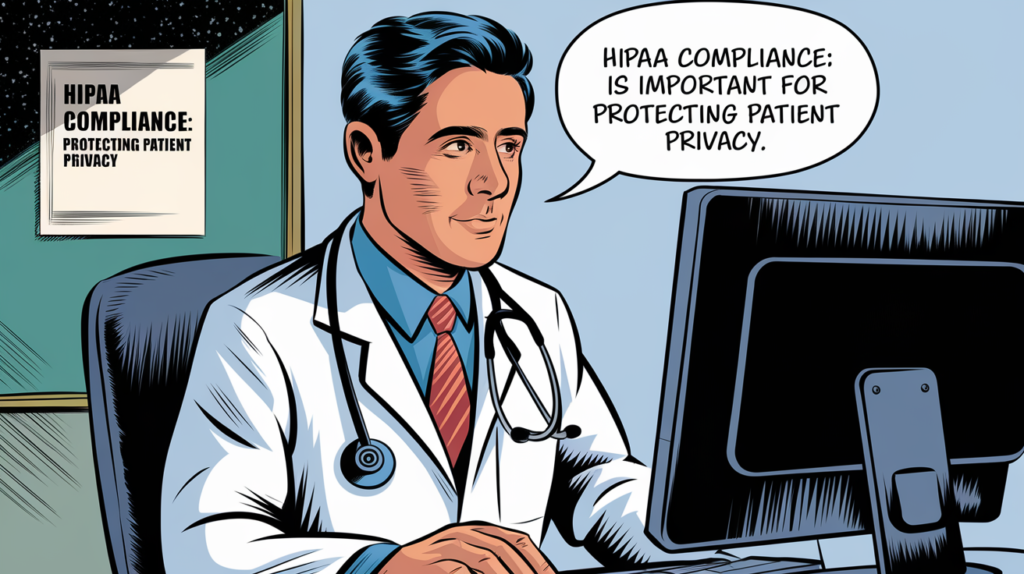
HIPAA, or the Health Insurance Portability and Accountability Act, contains a set of rules on how to deal with data. Who should refer to it? Practically any business that deals with sensitive health-related information. Answering the most common question — the list extends far beyond just health institutions.
So, should your enterprise comply? And which rules to follow? All of this is covered in this HIPAA guideline.
HIPAA Compliance Definition
HIPAA is a U.S. law designed to safeguard sensitive patient information. It sets national standards for protecting patient data from unauthorized electronic and physical access.
More specifically, it covers:
- The right of patients to have privacy,
- The measures that should be adopted to protect data,
- Actions that must be taken in case of data breaches and leakages.
Sure, at first, all those regulations may seem too tangled and complex. Many enterprises entrust their safety to a reputable HIPAA compliance company. Taking into account years-long experience and hundreds of successful cases, addressing a professional has proven to be the most stress-free and cost-efficient approach.

Who Must Comply with HIPAA?
Following HIPAA guidelines is mandatory for two main groups: covered entities and business associates. We’re about to discuss both in detail.
Covered entities include anyone directly related to the healthcare industry: healthcare providers, health plans, and healthcare clearinghouses. Hospitals, clinics, insurance companies, and any other organization directly dealing with patient data must adhere to HIPAA regulations.
Business associates are third-party vendors that work with covered entities and have access to protected health information (PHI). Billing companies, cloud service providers, or IT consultants are all included in this group. If you handle or transmit PHI on behalf of a covered entity, you must also follow the rule.
HIPAA Compliance Rules Checklist
An overview of HIPAA compliance involves discussing several rules, each of which must be followed for complete compliance. Here’s the full list.
Privacy Rule
The HIPAA Privacy Rule protects patients’ medical records in the broadest sense. It gives patients the right to access their medical data and control how it’s shared. The rule covers:
- Any past, present, or future information on mental or physical health conditions;
- Medical treatment details;
- Any information that covers healthcare-related payments and expenditures.
According to this rule, related information can be revealed only in a limited number of cases, which include specific treatment, research, or legal situations.
Privacy Rule Compliance Checklist
Data breaches in the sphere of healthcare will inevitably bring financial, reputational, and legal consequences. HIPAA is about minimizing the related risks. However, matching all the privacy rules can initially seem an unbearable task. It’s where a checklist with all the necessary steps can come in handy.
☑ Appoint or hire a privacy officer;
☑ Develop and implement applicable policies — all in the written format;
☑ Make sure that all related personnel is trained and instructed;
☑ Receive patient consent for certain disclosures;
☑ Ensure that any health-related information is shielded;
☑ Establish a system that can review and verify requests for protected patient information;
☑ Ensure patient access to any information when they request it;
☑ If breaches happen, be sure to notify all related parties;
☑ Establish protocols for sharing protected information with business associates and other third parties.
Security Rule
HIPAA compliance guidelines in terms of security focus on protecting electronic protected health information (ePHI). It provides the must-follow rules for technologies, administration, physical protection, and anything related to safety.
The rules outlined in this part can generally be divided into three groups.
Administrative Tasks
The group includes policies and procedures that can impact ePHI. However, it also covers human-related parts of a healthcare organization, such as managing Human Resources or employee training.
Physical Resources
This part lists requirements for securing physical elements like computers, switchers, routers, and data storage. Thus, entities covered by the law must guarantee that only entitled personnel have access to these components.
Technical Part
This part covers anything related to the technical part of storing and communicating ePHI. In particular, it covers computers, mobile phones, device and network security, and encryption.
HIPAA Security Rule Compliance Checklist
Just like with privacy rules, be sure to take the steps covered in this HIPAA implementation guide:
☑ Conduct detailed risk analysis;
☑ Implement any applicable policies for shielding the patient information;
☑ Ensure rigid personnel access controls to protected info;
☑ Check if the data is encrypted;
☑ Create a plan to respond to security breaches;
☑ Train related team members on HIPAA rules;
☑ Keep reviewing and upgrading your measures;
☑ Check if all your vendors comply with HIPAA.
Breach Notification Rule
No matter how well-protected, each organization can eventually face a breach. So, the Breach Notification Rule specifies the steps that should be taken in such cases:
- Notifying affected parties,
- Providing the notice during 60 days after the breach,
- The company should ensure a media notice if the case affects more than 500 people.
Omnibus Rule
This rule is relatively recent. Its primary function is to expand the responsibilities of business associates and introduce stronger penalties for non-compliance. According to it, now-covered entities are responsible for any potential violations of business associates. This fact encourages them to upgrade their risk assessment, gap analysis, and compliance procedures accordingly.
Enforcement Rule
This rule outlines the penalties for non-compliance with HIPAA. Depending on the severity of the violation, fines start at as low as $100. But they can sky-rocket to $50,000 and even $1.5 million per violation. These strict, sometimes even over-the-top sums were implemented to guarantee that all related businesses comply with the rules.
Conclusion
HIPAA compliance is a continuous process that requires regular updates, employee training, and constant monitoring. As you follow this guide, remember that protecting patient data can also build trust with clients and partners. Follow this HIPAA compliance guideline to ensure your business stays compliant and protected.



